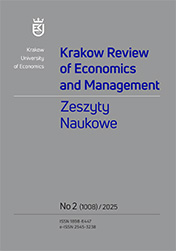Geopolitical Risk and Military Spending in Poland
DOI:
https://doi.org/10.15678/krem.18626Keywords:
external security risk, defence burden, demand, expenditure, cointegrationAbstract
Objective: To examine the impact of geopolitical risk on military spending in Poland in the years 1993–2022.
Research Design & Methods: Autoregressive distributed lags, error correction, and Granger causality test were used.
Findings: Polish budgetary spending on defence is influenced by geopolitical risk in both the short and long term.
Implications / Recommendations: An increase in geopolitical risk motivates the Polish government to increase its military spending.
Contribution: The research verifies the theoretical nexus between external security risk and defence burden in Poland, a study which had never been done.
Downloads
References
Aizenman, J., & Glick, R. (2003). Military Expenditure, Threats, and Growth (NBER Working Paper No. 9618). National Bureau of Economic Research. DOI: https://doi.org/10.3386/w9618
Benoit, E. (1973). Defense and Economic Growth in Developing Countries. Lexington Books.
Caldara, D., & Iacoviello, M. (2022). Measuring Geopolitical Risk. American Economic Review, 112(4), 1194–1225. https://doi.org/10.1257/aer.20191823 DOI: https://doi.org/10.1257/aer.20191823
Clements, B. J., Gupta, S., & Khamidova, S. (2021). Is Military Spending Converging to a Low Level across Countries? Economic Modelling, 94, 433–441. https://doi.org/10.1016/j.econmod.2020.10.010 DOI: https://doi.org/10.1016/j.econmod.2020.10.010
Collier, P., & Hoeffler, A. (2002). Military Expenditure: Threats, Aid and Arms Races (Policy Research Working Paper No. 2927). World Bank. DOI: https://doi.org/10.1596/1813-9450-2927
Demirci, O., & Ayyıldız, F. V. (2023). Jeopolitik Risklerin ve Savunma Harcamalarının İktisadi Büyümeyle İlişkisi: MIST Ülkeleri Örneği [The Relationship of Geopolitical Risks and Defense Expenditures with Economic Growth: The Example of MIST Countries]. Fiscaoeconomia, 7(3), 1929–1947. https://doi.org/10.25295/fsecon.1277050 DOI: https://doi.org/10.25295/fsecon.1277050
Dimitraki, O., & Win, S. (2021). Military Expenditure Economic Growth Nexus in Jordan: An Application of ARDL Bound Test Analysis in the Presence of Breaks. Defence and Peace Economics, 32(7), 864–881. https://doi.org/10.1080/10242694.2020.1730113 DOI: https://doi.org/10.1080/10242694.2020.1730113
Eichenberg, R. C., & Stoll, R. (2003). Representing Defense: Democratic Control of the Defense Budget in the United States and Western Europe. The Journal of Conflict Resolution, 47(4), 399–422. DOI: https://doi.org/10.1177/0022002703254477
Ficoń, K. (2020). Bezpieczeństwo narodowe i jego typologie. Bel Studio.
Flores, A. Q. (2011). Alliances as Contiguity in Spatial Models of Military Expenditures. Conflict Management and Peace Science, 28(4), 402–418. https://doi.org/10.1177/0738894211413064 DOI: https://doi.org/10.1177/0738894211413064
Francis, D. (2023). Poland is Leading Europe’s Response to the Russian Invasion of Ukraine. Atlantic Council. Retrieved from: https://www.atlanticcouncil.org/blogs/ukrainealert/poland-is-leading-europes-response-to-the-russian-invasion-of-ukraine/ (accessed: 10.02.2024).
George, J., & Sandler, T. (2018). Demand for Military Spending in NATO, 1968–2015: A Spatial Panel Approach. European Journal of Political Economy, 53, 222–236. https://doi.org/10.1016/j.ejpoleco.2017.09.002 DOI: https://doi.org/10.1016/j.ejpoleco.2017.09.002
Goldberg, M. S. (2018). Casualty Rates of US Military Personnel during the Wars in Iraq and Afghanistan. Defence and Peace Economics, 29(1), 44–61. https://doi.org/10.1080/10242694.2015.1129816 DOI: https://doi.org/10.1080/10242694.2015.1129816
GPR Statistics. Data downloaded from: https://www.matteoiacoviello.com/gpr.htm (accessed: 10.04.2023).
Granger, C. W. J. (1969). Investigating Causal Relations by Econometric Models and Cross-spectral Methods. Econometrica, 37(3), 424–438. https://doi.org/10.2307/1912791 DOI: https://doi.org/10.2307/1912791
Hall, B., Flemming, S., & Shotter, J. (2021). How Migration Became a Weapon in a ‘Hybrid War’. Financial Times. Retrieved from: https://www.ft.com/content/83ece7e4-cc71-45b5-8db7-766066215612 (accessed: 3.04.2023).
Hartley, T., & Russett, B. (1992). Public Opinion and the Common Defense: Who Governs Military Spending in the United States? American Political Science Review, 86(4), 905–915. https://doi.org/10.2307/1964343 DOI: https://doi.org/10.2307/1964343
Herz, J. H. (1950). Idealist Internationalism and the Security Dilemma. World Politics, 2(2), 157–180. https://doi.org/10.2307/2009187 DOI: https://doi.org/10.2307/2009187
Hou, N., & Chi, Z. (2022). Sino-U.S. Relations and the Demand for Military Expenditure in the Indo-Pacific Region. Defence and Peace Economics, 33(6), 751–766. https://doi.org/10.1080/10242694.2021.1904358 DOI: https://doi.org/10.1080/10242694.2021.1904358
Khan, K., Khurshid, A., & Cifuentes-Faura, J. (2023). Investigating the Relationship between Geopolitical Risks and Economic Security: Empirical Evidence from Central and Eastern European Countries. Resources Policy, 85, 103872. https://doi.org/10.1016/j.resourpol.2023.103872 DOI: https://doi.org/10.1016/j.resourpol.2023.103872
Khan, K., Su, C.-W., & Rizvi, S. K. A. (2022). Guns and Blood: A Review of Geopolitical Risk and Defence Expenditures. Defence and Peace Economics, 33(1), 42–58. https://doi.org/10.1080/10242694.2020.1802836 DOI: https://doi.org/10.1080/10242694.2020.1802836
Mickolus, E. F., Sandler, T., Murdock, J. M., & Flemming, P. A. (2011). International Terrorism: Attributes of Terrorist Events, 1968–2010 (ITERATE). Vinyard Software.
Murdoch, J. C., & Sandler, T. (1982), A Theoretical and Empirical Analysis of NATO. Journal of Conflict Resolution, 26(2), 237–263. https://doi.org/10.1177/0022002782026002003 DOI: https://doi.org/10.1177/0022002782026002003
Nkoro, E., & Uko, A. K. (2016). Autoregressive Distributed Lag (ARDL) Cointegration Technique: Application and Interpretation. Journal of Statistical and Econometric Methods, 5(4), 63–91.
Nordhaus, W., Oneal, J. R., & Russet, B. (2012). The Effects of the International Security Environment on National Military Expenditures: A Multicountry Study. International Organization, 66(3), 491–513. https://doi.org/10.1017/S0020818312000173 DOI: https://doi.org/10.1017/S0020818312000173
Okamura, M. (1991). Estimating the Impact of the Soviet Union’s Threat on the United States–Japan Alliance: A Demand System Approach. The Review of Economics and Statistics, 73(2), 200–207. https://doi.org/10.2307/2109509 DOI: https://doi.org/10.2307/2109509
Pesaran, M. H., & Pesaran, B. (1997). Working with Microfit 4.0: Interactive Econometric Analysis. Oxford University Press.
Pesaran, M. H., Shin, Y., & Smith, R. J. (2001). Bounds Testing Approaches to the Analysis of Level Relationships. Journal of Applied Econometrics, 16(3), 289–326. https://doi.org/10.1002/jae.616 DOI: https://doi.org/10.1002/jae.616
SIPRI Statistics. https://www.sipri.org/databases (accessed: 30.04.2023).
Smith, R. P. (1980). The Demand for Military Expenditure. The Economic Journal, 90(360), 811–820. https://doi.org/10.2307/2231744 DOI: https://doi.org/10.2307/2231744
Sweidan, O. D. (2023). Geopolitical Risk and Military Expenditures: Evidence from the US Economy. Russian Journal of Economics, 9(2), 201–218. https://doi.org/10.32609/j.ruje.9.97733 DOI: https://doi.org/10.32609/j.ruje.9.97733
Topal, M. H., Unver, M., & Türedi, S. (2022). The Military Expenditures and Economic Growth Nexus: Panel Bootstrap Granger Causality Evidence from NATO Countries. Panoeconomicus, 69(4), 555–578. https://doi.org/10.2298/PAN170914002T DOI: https://doi.org/10.2298/PAN170914002T
Topcu, M., & Aras, I. (2017). Military Expenditures and Economic Growth in Central and Eastern EU Countries: Evidence from the Post-Cold War Era. European Review, 25(3), 453–462. https://doi.org/10.1017/S1062798717000114 DOI: https://doi.org/10.1017/S1062798717000114
Waszkiewicz, G., Kutasi, G., & Marton, Á. (2025). The Socio-economic Perspective for the Guns vs. Butter Trade-off in The European Union Countries. Folia Oeconomica Stetinensia, 25(1), 337–353. https://doi.org/10.2478/foli-2025-0017 DOI: https://doi.org/10.2478/foli-2025-0017
Waszkiewicz, G., & Taksás, B. (2023). Military Spending among European NATO Members. The Importance of Strategic Factors after 2014. Journal of Security and Sustainability Issues, 13(1), 53–63. https://doi.org/10.47459/jssi.2023.13.5 DOI: https://doi.org/10.47459/jssi.2023.13.5
Downloads
Published
Issue
Section
License
Copyright (c) 2025 Krakow University of Economics

This work is licensed under a Creative Commons Attribution 4.0 International License.

